Related Research Articles
William Boyd Watterson II is an American cartoonist and the author of the comic strip Calvin and Hobbes, which was syndicated from 1985 to 1995. Watterson stopped drawing Calvin and Hobbes at the end of 1995, with a short statement to newspaper editors and his readers that he felt he had achieved all he could in the medium. Watterson is known for his negative views on comic syndication and licensing, his efforts to expand and elevate the newspaper comic as an art form, and his move back into private life after he stopped drawing Calvin and Hobbes. Watterson was born in Washington, D.C., and grew up in Chagrin Falls, Ohio. The suburban Midwestern United States setting of Ohio was part of the inspiration for Calvin and Hobbes.
Bill Holbrook is an American cartoonist and webcomic writer and artist, best known for his syndicated comic strip On the Fastrack.

A comic strip is a sequence of cartoons, arranged in interrelated panels to display brief humor or form a narrative, often serialized, with text in balloons and captions. Traditionally, throughout the 20th and into the 21st century, these have been published in newspapers and magazines, with daily horizontal strips printed in black-and-white in newspapers, while Sunday papers offered longer sequences in special color comics sections. With the advent of the internet, online comic strips began to appear as webcomics.
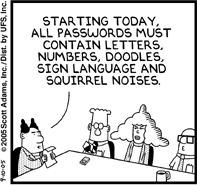
Dilbert is an American comic strip written and illustrated by Scott Adams, first published on April 16, 1989. It is known for its satirical office humor about a white-collar, micromanaged office with engineer Dilbert as the title character. It has spawned dozens of books, an animated television series, a video game, and hundreds of themed merchandise items. Dilbert Future and The Joy of Work are among the most read books in the series. In 1997, Adams received the National Cartoonists Society Reuben Award and the Newspaper Comic Strip Award for his work. Dilbert appears online and as of 2013 was published daily in 2,000 newspapers in 65 countries and 25 languages.
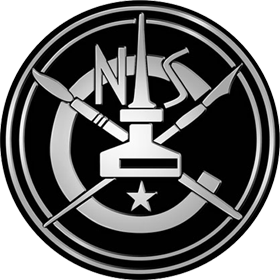
The National Cartoonists Society (NCS) is an organization of professional cartoonists in the United States. It presents the National Cartoonists Society Awards. The Society was born in 1946 when groups of cartoonists got together to entertain the troops. They enjoyed each other's company and decided to meet on a regular basis.
Webcomics are comics published on a website or mobile app. While many are published exclusively on the web, others are also published in magazines, newspapers, or comic books.
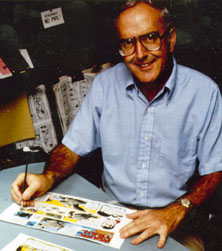
A cartoonist is a visual artist who specializes in both drawing and writing cartoons or comics. Cartoonists differ from comics writers or comic book illustrators in that they produce both the literary and graphic components of the work as part of their practice. Cartoonists may work in a variety of formats, including booklets, comic strips, comic books, editorial cartoons, graphic novels, manuals, gag cartoons, storyboards, posters, shirts, books, advertisements, greeting cards, magazines, newspapers, webcomics, and video game packaging.

William J. C. Amend III is an American cartoonist. He is known for his comic strip FoxTrot.

John Lewis Hart was an American cartoonist noted as the creator of the comic strips B.C. and The Wizard of Id. Brant Parker co-produced and illustrated The Wizard of Id. Hart was recognized with several awards, including the Swedish Adamson Award and five from the National Cartoonists Society. In his later years, he was known for incorporating Christian themes and messages into his strips. Hart was referred to by Chuck Colson in a Breakpoint column as "the most widely read Christian of our time," over C. S. Lewis, Frank E. Peretti, and Billy Graham.
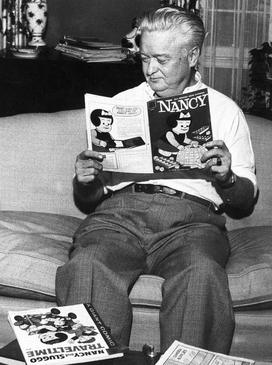
Ernest Paul Bushmiller Jr. was an American cartoonist, best known for creating the daily comic strip Nancy, which premiered in 1938 and features the title character who has remained in print for over 85 years. His work is noted for its simple graphic style. In 1976, he received the Reuben Award from the National Cartoonists Society for his work on Nancy.
James Mark Borgman is an American cartoonist. He is known for his political cartoons and his nationally syndicated comic strip Zits. He was the editorial cartoonist at The Cincinnati Enquirer from 1976 to 2008.
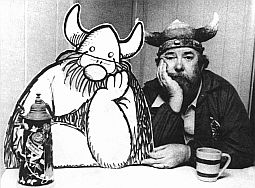
Richard Arthur Allan Browne was an American cartoonist, best known for writing and drawing Hägar the Horrible and Hi and Lois.

David Wiley Miller is an American cartoonist whose work is characterized by wry wit and trenchant social satire, is best known for his comic strip Non Sequitur, which he signs Wiley. Non Sequitur is the only cartoon to win National Cartoonists Society Divisional Awards in both the comic strip and comic panel categories, and Miller is the only cartoonist to win an NCS Divisional Award in his first year of syndication.

Jerry Scott is an American cartoonist and writer. He is known for co-creating the comic strips Baby Blues and Zits. He is one of only four cartoonists to have multiple strips appearing in over 1,000 newspapers worldwide.
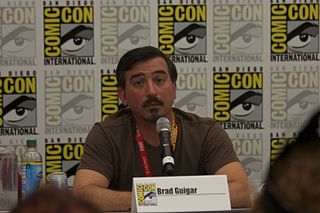
Brad Guigar is an American cartoonist who is best known for his daily webcomic Greystone Inn and its sequel Evil Inc.
Brian Crane is an American cartoonist who created Pickles, a comic strip featuring a retired couple, Earl and Opal Pickles, their family, and their family pets, Muffin (cat) and Roscoe (dog).
Brian Basset is an American comic strip artist. Previously, he worked as an editorial cartoonist for the Seattle Times from 1978 to 1994, as well as being the creator and artist behind the syndicated comic strip Adam, later changed to Adam@home (1984-2009).

Jonathan Rosenberg is the webcomic artist responsible for Goats, Scenes from a Multiverse and megaGAMERZ 3133T. Rosenberg has been producing webcomics since 1997, making him one of the original webcomic artists. When the National Cartoonists Society added a new category, Online Comic Strips, in 2011, Rosenberg was the first winner.
Although, traditionally, female comics creators have long been a minority in the industry, they have made a notable impact since the very beginning, and more and more female artists are getting recognition along with the maturing of the medium. Women creators have worked in every genre, from superheroes to romance, westerns to war, crime to horror.